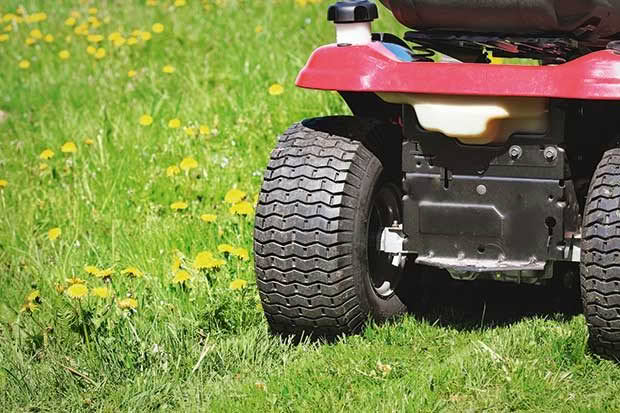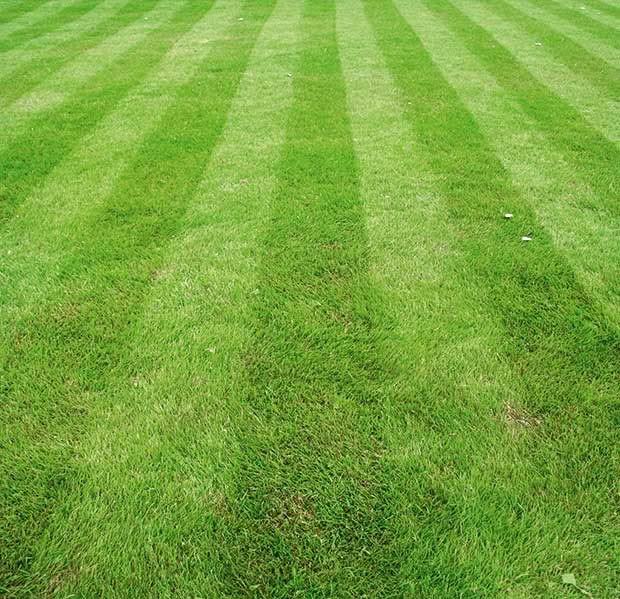The best ways to mow your lawn (and nail those lawn stripes)

It is always a challenge to work out the most efficient way to mow a lawn. Clockwise? Anti-clockwise? Rows? Spirals? The answer is, it depends.
Words: Nadene Hall
The most efficient way to mow a lawn isn’t such a simple answer. Here’s why:
1. What side does your ride-on discharge clippings?
There are two schools of thought. If your mower sends clippings out to the right, mow in a clockwise direction. This means you mow over the clippings you’ve just cut, slowly shuffling them into the middle of the lawn.
Some will disappear with all the cutting and re-cutting. The remainder will form one final row of clippings which is easy to rake up. You will also avoid blowing clippings into the side of buildings or through a window or door.
However, if your grass is long and/or wet, it’s a better idea to mow so clippings are blowing to the outside. This way, you don’t have to mow over them which can block up your deck and create random clumps of wet grass.
2 Are you mowing in rows or circles?
Some very keen people at Popular Mechanics magazine asked a master puzzler to work out what was more efficient: mowing in straight lines or spirals. To make it easy, they worked it out assuming a flat area of lawn with no trees or garden beds.
The most important factor is not to mow over the same area twice. That’s easy if you have a zero-turn mower but more of a problem if you don’t.
They also calculated how many turns it took, comparing rows and spirals. For the area they set up, it required a lot of mathematics to work out they both required a total of 30 turns.
The result was a tie.
HOW TO MOW LAWN STRIPES

To get the perfect striped lawn on a ride-on mower, you take lessons from ice hockey. The machines used to smooth ice use a set pattern that translates well to lawns.
1. Mow around the outside edge of the lawn, creating a ‘frame’.
2. Mow down the middle of the area, then turn to either of the outside edges and mow back down that side.
3. Go back to the middle and mow beside your first pass on the opposite side of the outside edge you mowed in Step
4. Repeat the pattern until you finish.
This should leave your lawn looking half dark-green, half light-green. In the lighter-looking stripe, the grass is bending away from you; where it’s darker, it has been bent towards you.
The effect won’t be strong, unless you use a roller behind your mower to ‘bend’ the cut grass. You can buy these, or some keen people make their own (search Google or Youtube for examples). On sports fields, the patterns in grass are far more effective, achieved using large reel mowers and heavy rollers.
2 IMPORTANT THINGS TO KNOW IF YOU’RE PLANNING TO DO DIY MAINTENANCE
1. If you’re working on a ride-on mower, don’t tip it on its side. Check the service manual for recommendations first. If you tip it the wrong way, oil will flow into the air filter and/or carburettor and you won’t be able to start the machine.
2. If your property is hilly, expect to do more maintenance than if you run the same machine on easier terrain.
4 THINGS TO DO BEFORE YOU USE YOUR RIDE-ON

• Check the belt/s for wear, and that the idler pulley is holding the belt/s at the correct tension.
• Check blades, safety flaps and any attachments are secure, and nothing is loose.
• Check the engine has oil and the correct fuel in it.
• Check tyre pressure. A partly-deflated tyre will cause the deck to cut grass unevenly, or may scalp it. It will also damage the tyre. Turf tyres can be expensive, depending on the size and age of the mower.Your ride-on mower’s manual should tell you the correct tyre pressure. It’s far lower than a car, usually around 10psi for rear tyres, and 12-14psi for front tyres. The recommended PSI is usually also written on the sidewall of the tyre.
Love this story? Subscribe now!
 This article first appeared in NZ Lifestyle Block Magazine.
This article first appeared in NZ Lifestyle Block Magazine.
